
A sidelifter is a specialised vehicle or semi-trailer used to hoist and transport ISO standard intermodal containers over longer distances.

A sidelifter is a specialised vehicle or semi-trailer used to hoist and transport ISO standard intermodal containers over longer distances.
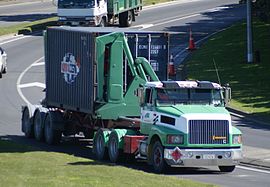
The sidelifter loads and unloads containers via a pair of hydraulic powered cranes mounted at each end of the vehicle chassis. The cranes are designed to lift containers from the ground, from other vehicles including rolling stock, from railway wagons and directly from stacks on docks or aboard container ships. A standard sidelifter is also able to stack a container at a two containers' height on the ground. If the sidelifter chassis is of 40' length or more, the cranes of the sidelifter can be shifted hydraulically along the sidelifter chassis to be able to pick up either one 20', one 40', or two 20' ISO containers at a time.
As the Sidelifter is suitable for travelling on general roads for large distances and able to quickly load and unload without additional equipment, it is often used for delivering and picking up shipping containers from within a commercial district. Although these can self load, they are more often loaded or unloaded at the port with a straddle carrier or reach stacker.
This equipment has been referred to with a myriad of alternate names. Some of these are:
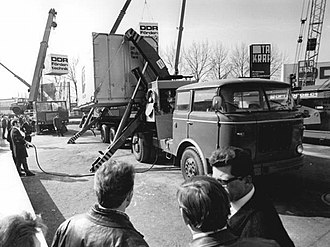
The sidelifter was invented during the 1960s by Kaspar Klaus who was granted a number of patents for the equipment manufactured by Klaus Transport-systeme GmbH of Germany, [1] with a focus on military operations. [2] The Klaus Sidelifters were heavy and not cost effective for commercial use. Steelbro in New Zealand bought the Klaus Transport business and further developed the Sidelifter, [3] resulting in reduced tare weight and allowing freight companies to legally carry higher payload. It was also developed by Hammar Maskin AB in Sweden. [4] It has since become a commonly used vehicle in intermodal facilities worldwide. [5] The principal alternative to the costly machinery of the sidelifter is the use of swap body containers, which are too light to be stacked but can be unloaded from a truck by means of foldable legs.
Sidelifters generally have the following attributes:
Sidelifter machines were designed to lift a maximum of 45 tonnes (50 short tons ; 44 long tons ). More recent designs lift 47 tonnes (52 short tons; 46 long tons) though smaller machines are also available where a lighter tare weight is important.
In addition to controlling the raising and lowering of the cranes, the operator can sometimes tilt the chassis using the stabilising legs which provides a limited ability to operate on non-level ground.
Some sidelifters have a telescopic chassis, sometimes called trombone chassis, allowing the unit to expand and contract in order to accommodate 20 ft, 40 ft or even 45 ft containers. These Trombone units are specially suited for small secondary roads where cornering is quite difficult with 40 ft trailers.

A sidelifter is rated for ISO containers with a specified maximum total weight and to a maximum distance from the sidelifter chassis (also called maximum reach or maximum radius). This information is located on a nameplate provided by the manufacturer, and loads must not exceed these specifications. Sidelifter units have been known to overturn like any other crane, especially when lifting weights that are heavier than the maximum allowed weight or when operating at a radius that is bigger than the maximum allowed radius. Sidelifter units must always be operated only by trained personnel. Safety devices such as Electronic Stability System that prevent the sidelifter from rolling over may be sometimes required by local legislation. Safetywear for the operator and any assistants can include top and bottom reflector gear including a green or orange reflector vest and hard hat. In some jurisdictions safety goggles are required to protect against debris that can fall from containers.
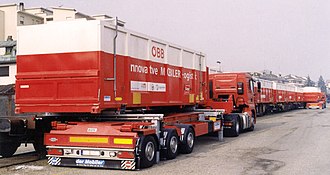
A Rubber tyred gantry crane is another device for loading containers on to trucks (as well as around the port) although these are not road-going so must be in place at every destination that containers are to be delivered or collected at. As well a general purpose tilt deck truck (also called a tilt tray, rollback or a slide) equipped with a winch can load/unload a 20-foot container from the rear of the vehicle.
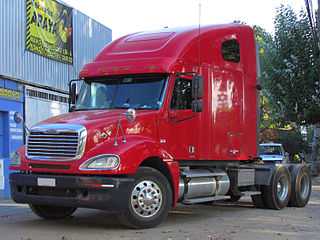
A semi-tractor-trailer truck, also known as simply a semi-trailer truck, semi-tractor truck, semi-tractor-trailer or tractor-trailer truck, is the combination of a tractor unit and one or more semi-trailers to carry freight. A semi-trailer attaches to the tractor with a type of hitch called a fifth-wheel.

A truck or lorry is a motor vehicle designed to transport cargo, carry specialized payloads, or perform other utilitarian work. Trucks vary greatly in size, power, and configuration, but the vast majority feature body-on-frame construction, with a cabin that is independent of the payload portion of the vehicle. Smaller varieties may be mechanically similar to some automobiles. Commercial trucks can be very large and powerful and may be configured to be mounted with specialized equipment, such as in the case of refuse trucks, fire trucks, concrete mixers, and suction excavators. In American English, a commercial vehicle without a trailer or other articulation is formally a "straight truck" while one designed specifically to pull a trailer is not a truck but a "tractor".

An intermodal container, often called a shipping container, is a large standardized shipping container, designed and built for intermodal freight transport, meaning these containers can be used across different modes of transport – from ship to rail to truck – without unloading and reloading their cargo. Intermodal containers are primarily used to store and transport materials and products efficiently and securely in the global containerized intermodal freight transport system, but smaller numbers are in regional use as well. These containers are known under a number of names, such as simply container, cargo or freight container, ISO container, shipping, sea or ocean container, sea van or (CONEX) box, container van, sea can, c can, MILVAN, SEAVAN, or RO/RO.

A crane is a type of machine, generally equipped with a hoist rope, wire ropes or chains, and sheaves, that can be used both to lift and lower materials and to move them horizontally. It is mainly used for lifting heavy things and transporting them to other places. The device uses one or more simple machines to create mechanical advantage and thus move loads beyond the normal capability of a human. Cranes are commonly employed in transportation for the loading and unloading of freight, in construction for the movement of materials, and in manufacturing for the assembling of heavy equipment.

Intermodal freight transport involves the transportation of freight in an intermodal container or vehicle, using multiple modes of transportation, without any handling of the freight itself when changing modes. The method reduces cargo handling, and so improves security, reduces damage and loss, and allows freight to be transported faster. Reduced costs over road trucking is the key benefit for inter-continental use. This may be offset by reduced timings for road transport over shorter distances.
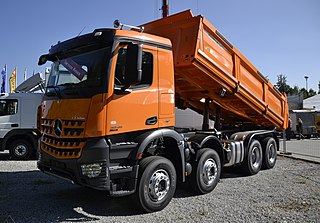
A dump truck, known also as a dumping truck, dump trailer, dumper trailer, dump lorry or dumper lorry or a dumper for short, is used for transporting materials for construction as well as coal. A typical dump truck is equipped with an open-box bed, which is hinged at the rear and equipped with hydraulic rams to lift the front, allowing the material in the bed to be deposited ("dumped") on the ground behind the truck at the site of delivery. In the UK, Australia, South Africa and India the term applies to off-road construction plants only and the road vehicle is known as a tip lorry, tipper lorry, tipper truck, tip truck, tip trailer or tipper trailer or simply a tipper.

A swap body, swop body, exchangeable container or interchangeable unit, is one of the types of standard freight containers for road and rail transport.

A container crane is a type of large dockside gantry crane found at container terminals for loading and unloading intermodal containers from container ships.

The Palletized Load System (PLS) is a truck-based logistics system that entered service in the United States Army in 1993. It performs long and short distance freight transport, unit resupply, and other missions in the tactical environment to support modernized and highly mobile combat units. It provides rapid movement of combat configured loads of ammunition and all classes of supply, shelters and intermodal containers. It is similar to systems such as the British Demountable Rack Offload and Pickup System (DROPS).

A semi-trailer is a trailer without a front axle. In the United States, the term is also used to refer to the combination of a truck and a semi-trailer; a tractor-trailer.

A straddle carrier or straddle truck is a freight-carrying vehicle that carries its load underneath by "straddling" it, rather than carrying it on top like a conventional truck. The advantage of the straddle carrier is its ability to load and unload without the assistance of cranes or forklifts. The lifting apparatus under the carrier is operated by the driver without any outside assistance and without leaving the driver's seat.
Hydraulic hooklift hoists are mounted on heavy duty trucks to enable hauliers to change out flatbeds, dumpster bodies, and similar containers. Primarily used in conjunction with tilt frame bodies and specialised roller containers, generally designed for the transportation of materials in the waste, recycling, scrap and demolition industries, as well as for disposal of construction debris.
A specialized set of jargon describe the tools, equipment, and employment sectors used in the trucking industry in the United States. Some terms may be used within other English-speaking countries, or within the freight industry in general. For example, shore power is a term borrowed from shipping terminology, in which electrical power is transferred from shore to ship, instead of the ship relying upon idling its engines. Drawing power from land lines is more efficient than engine idling and eliminates localized air pollution. Another borrowed term is "landing gear", which refers to the legs which support the front end of a semi-trailer when it is not connected to a semi-truck. Some nicknames are obvious wordplay, such as "portable parking lot", in reference to a truck that carries automobiles.

A tank transporter is a combination of a heavy tractor unit and a mating full trailer or semi-trailer, used for transporting tanks and other armoured fighting vehicles. Some also function as tank recovery vehicles, the tractors of which may be armoured for protection in combat conditions.
Trailer on flatcar, also known as TOFC or piggyback, is the practice of carrying semi-trailers on railroad flatcars. TOFC allows for shippers to move truckloads long distances more cheaply than can be done by having each trailer towed by a truck, since one train can carry more than 100 trailers at once. The trailers will be moved by truck from their origin to an intermodal facility, where they will then be loaded onto a train, typically by a rubber tyred gantry crane, for the bulk of their journey. Alternatively, trailers may be driven onto the flatcars via ramps by a terminal tractor. Near the destination, the trailers are unloaded at another facility and brought to their final destination by a tractor unit.

A car carrier trailer, also known as a car-carrying trailer, car hauler, or auto transport trailer, is a type of trailer or semi-trailer designed to efficiently transport passenger vehicles via truck.

A roller container is a container type that can be carried by trucks to be pushed to ground level by help of a hook and level arm with the container possibly sliding on steel roller wheels.

Steelbro Group is a heavy vehicle and crane manufacturer headquartered in Victoria, Australia. In 2013 it owned the Steelbro, Transtank, Fuelgear and Freightquip businesses. It grew from the company Steelbro, headquartered in Christchurch, New Zealand.

Container chassis, also called intermodal chassis or skeletal trailer, is a specialized semi-trailer, basically a wheeled metal frame, that an intermodal container can be mounted onto for road transport. Chassis are used by truckers to deliver containers between ports, railyards, container depots, and shipper facilities. This type of trucking is sometimes called drayage.
The 'kangaroo wagon' is a type of wagon rail designed for the transport of semi-trailers. It has a drawbridge forming a pocket in the low position allowing the carrier train of the semi-trailer to be placed and thus to respect the height of the loading gauge.